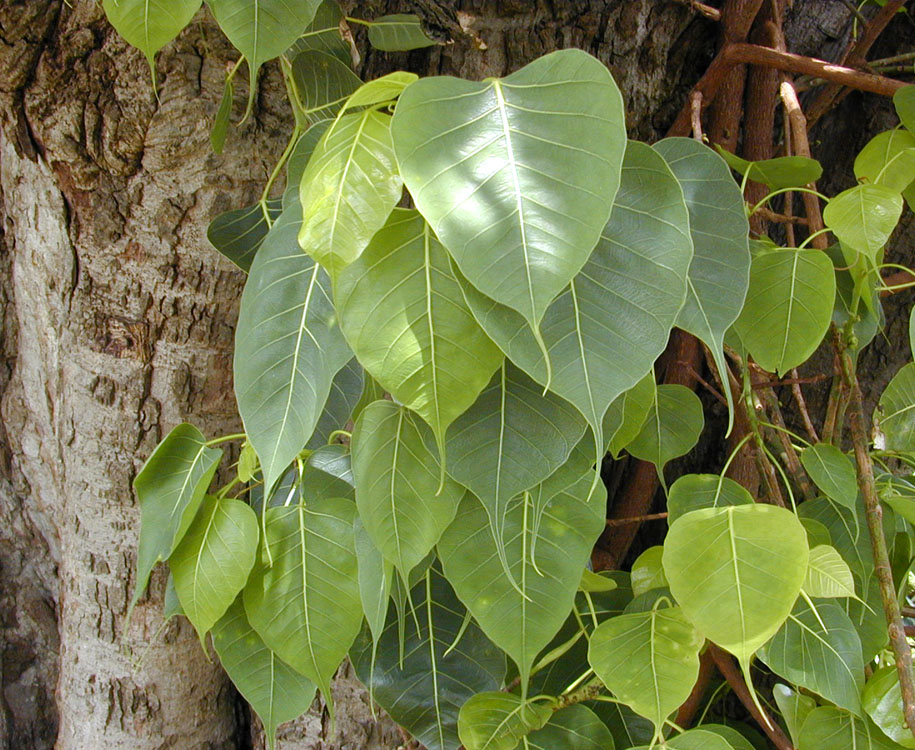- Sacred fig
image_width = 240px
image_caption = Leaves and trunk of a Sacred Fig. Note the distinctive leaf shape.
regnum =Plant ae
divisio = Magnoliophyta
classis =Magnoliopsida
ordo =Rosales
familia =Moraceae
genus = "Ficus "
species = "F. religiosa"
binomial = "Ficus religiosa"
binomial_authority = L.The Sacred Fig ("Ficus religiosa") or Bo-Tree (from the Sinhala "bo") ["Oxford English Dictionary", Oxford University Press, 1971, p.1014] is a
species ofbanyan fig native toSri Lanka ,Nepal andIndia , southwestChina andIndochina east toVietnam . It is known by a wide range of local names, such as "Bo" or "pou" , bawdi or bawdi nyaung inBurmese language , Bodhi (โพธิ์) (inThai Language , though pronounced "Po"), "Pipal" ("peepal, peepul, pippala, pimpal", etc.), "arali" or "Ashvastha " tree. It is a largedry season -deciduous or semi-evergreen tree up to 30m tall and with a trunk diameter of up to 3 m.The leaves are in shape with a distinctive extended tip; they are 10-17cm long and 8-12cm broad, with a 6-10cm petiole. The
fruit is a small fig 1-1.5cm diameter, green ripening purple.The
Bodhi tree and theSri Maha Bodhi propagated from it are famous specimens of Sacred Fig. The known planting date of the latter,288 BC , gives it the oldest verified age for any angiosperm plant.This plant is considered sacred by the followers of
Hinduism ,Jainism andBuddhism , and hence the name 'Sacred Fig' was given to it.Siddhartha Gautama is referred to have been sitting underneath a Bo-Tree when he was enlightened (Bodhi), or "awakened" (Buddha). Thus, the Bo-Tree is well-known symbol for happiness, prosperity, longevity and good luck. Today in India, HinduSadhu s still meditate below this tree, and inTheravada Buddhist Southeast Asia , the tree's massive trunk is often the site of Buddhist and animist shrines.Plaksa
Plaksa is a possible Sanskrit term for the Sacred fig. According toMacdonell andKeith (1912), it rather denotes theWavy-leaved Fig tree ("Ficus infectoria ").In Hindu texts, the Plaksa tree is associated with the source of the [Sarasvati Radhakrishna, B.P. and Merh, S.S. (editors): Vedic Sarasvati, 1999, p.35-44 ]
Plaksa Pra-sravana denotes the place where the Sarasvati appears. [Pancavimsa Brahmana, Jaiminiya Upanisad Brahmana, Katyayana Srauta Sutra, Latyayana Srauta; Macdonell and Keith 1912] In the Srauta Sutra, Sankhayana Srauta Sutra; Macdonell and Keith 1912, II:55]
Notes
ee also
*
Sri Maha Bodhi
*Sitala References
*Keith and Macdonell. 1912. Vedic Index of Names and Subjects.
* [http://iu.ff.cuni.cz/pandanus/database/details.php?plantno=400094&enc=utf&sort=ka&display=50&reswind=this&lat=&skt=on&pkt=&tam=&start=0 Plaksa description]External links
* [http://iu.ff.cuni.cz/pandanus/database/details.php?plantno=800009&enc=utf&sort=ka&display=50&reswind=this&lat=&skt=on&pkt=&tam=&start=0 Sacred fig description]
* [http://www.thecolorsofindia.com/peepal/benefits-and-uses.html Benefits of Peepal]
*
Wikimedia Foundation. 2010.

